VOL.193 JUNE 2024
SUMMER FUN IN JAPAN: SEASIDE FESTIVALS AND EVENTS
[SCIENCE & TECHNOLOGY] Transparent Screen Film Enables Image Projection with Simple Application to Glass Windows
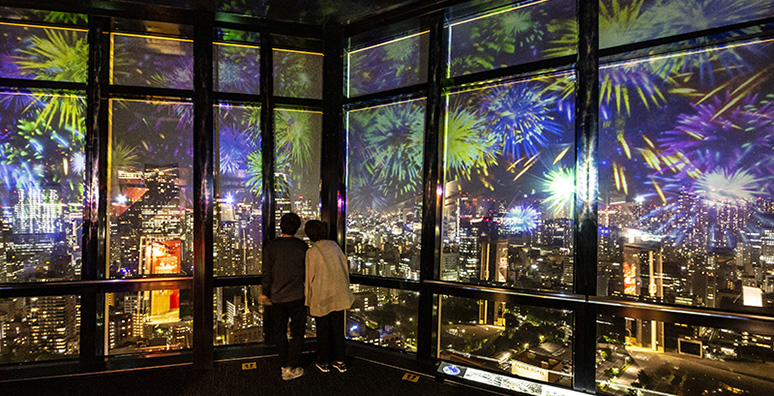
Kaleido Screen® is applied to the windows of Tokyo Tower’s observation deck for a projection mapping event.
The projection mapping event “TOKYO TOWER CITY LIGHT FANTASIA —Summer Landscape 2024” will run through September 1, featuring images of beautiful fireworks, falling stars, and more against the nighttime scenery of Tokyo.
Photo: ©TOKYO TOWER
Clear images can now be projected onto transparent glass windows, which light would ordinarily pass straight through. This advance has been made possible with light scattering* technology using nanodiamond particles. The technology was developed in an industry-academia collaboration project involving a university and private companies. Enabling practical use as a transparent screen, it offers an expanded range of applications, including projection mapping and digital signage on glass windows.
Repeated attempts have previously been made to project images onto transparent sheets of glass or acrylic plates. However, since these surfaces are transparent, light typically passes straight through them. In order to project images onto such surfaces, the light must be made to scatter rather than pass straight through when it hits the glass. It was a research team led by TOKITA Masatoshi, professor at the Tokyo Institute of Technology, and NISHIMURA Suzushi, specially appointed professor at the same university, that eventually succeeded in solving this dilemma. They began working on the difficult challenge in 2009, drawing on previous research they had done on nano** structural design.
Their work was conducted as part of the Strategic Promotion of Innovative Research and Development Program (S-Innovation), an initiative of the Japan Science and Technology Agency (JST), on the theme of “Developing New Device Technologies Through Polymer Nano Orientation Control.” S-Innovation was founded with the aim of supporting large-scale, innovative technological research through industry-academia collaboration. For this project, the Tokyo Institute of Technology served as the research leader and the ENEOS Corporation as the development leader. With the success of this technological development, professor TOKITA and specially appointed professor NISHIMURA were honored with the Award for Science and Technology (Development Category) for fiscal 2024 by the Minister of Education, Culture, Sports, Science and Technology (MEXT) for their work on transparent screen development.
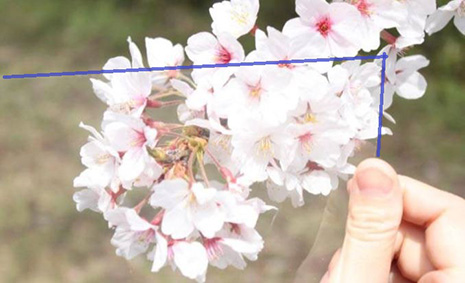
Photo: NISHIMURA Suzushi, Tokyo Institute of Technology
A key to their successful transparent screen development was “nanodiamond” material introduced by Vision Development Co., Ltd., a company that participated in the project. Nanodiamond is a type of carbon material, a form of artificial diamond produced by shock waves created by gunpowder explosions in airtight containers. They are extremely tiny, with particle diameters as small as about 5 nanometers. They have the same crystal structure as diamonds and are characterized by a high degree of hardness and high refractive index of light. Although it is generally difficult to disperse nanoparticles in a suitable manner, nanodiamond particles created with this method have the property of easily dispersing in water. Not only that, they disperse uniformly.
To create a thin film, nanodiamond particles are dispersed in polyvinyl alcohol3***(PVA), the base material of the film, in very low concentrations. If the particle concentration is too high, the film will become cloudy and white, lowering the degree of transparency. On the other hand, if it is too low, its light-scattering effectiveness is negatively affected, making it unsuitable for showing projecting images. Also, even extremely minor differences in the sizes of particles will affect the way the light is scattered, changing the way colors appear. After conducting processes of trial and error, changing the size and concentration of nanodiamond particles in the film, the team succeeded in establishing technology capable of showing projected images with colors that appear natural to the human eye, even while maintaining a high degree of transparency.
A film called Kaleido Screen®****, which can be applied to window glass, was then developed based on this technology. It caught the attention of video artists as a highly transparent film with the potential to transform glass surfaces into video displays and has been adopted at art events using large-scale projection mapping.
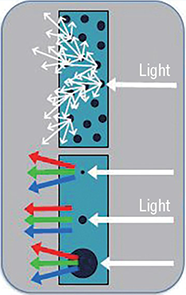
Figure: NISHIMURA Suzushi, Tokyo Institute of Technology
The transparent screens maintain views of city scenery through clear glass during the daytime, while also allowing visitors to later enjoy beautiful video projections matched to the nighttime scenery. Currently, the screens have been adopted in locations including the Tokyo Tower and Shibuya Hikarie facilities in Tokyo, observation and commercial facilities including Abeno Harukas in Osaka City, public facilities such as the Saga Prefectural Office, sports events, shops, and more, where they help attract visitors. The screens will undoubtedly be made use of in many more places in the future to create welcome signboard images for office buildings and provide digital signage projecting advertisements, announcements, and more.
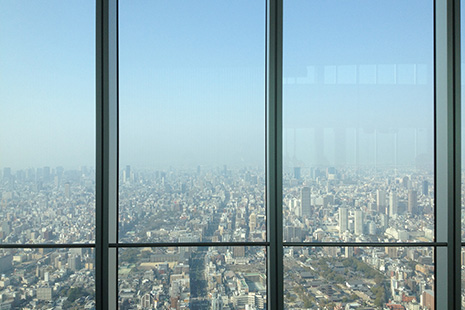
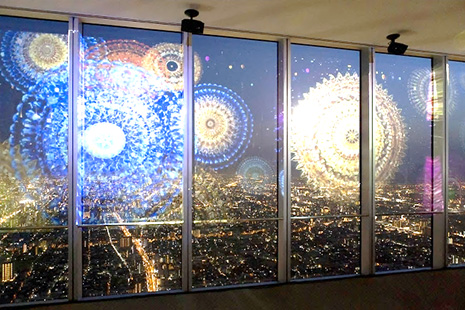
Daytime view (left) from the observation deck of the Abeno Harukas facilities in Osaka City and integration of image projection after dark with the actual nighttime scenery (right). The large glass windows, to which Kaleido Screen® has been applied, feature high transparency, allowing visitors to enjoy clear views out over Osaka.
Photo: NISHIMURA Suzushi, Tokyo Institute of Technology
* The diffusion of light in various directions when it hits physical media. Light that can be seen with the human eye is known as visible light. While the color of visible light is determined by wavelengths, if the balance of scattering in the wavelengths is poor, the colors will not have an attractive appearance.
** “Nano” is a prefix meaning “one billionth.” One nanometer (nm) is one billionth of a meter. Technology related to the research and development of extremely small materials is called nanotechnology.
*** A type of synthetic resin. It is used in liquid glues and adhesives, as well as in making textiles, fibers, and films.
**** A registered trademark of the ENEOS Corporation, a company that participated in the project
By FUKUDA Mistuhiro
Photo: NISHIMURA Suzushi, Tokyo Institute of Technology, ©TOKYO TOWER

